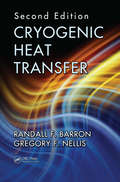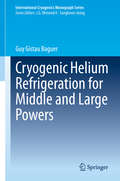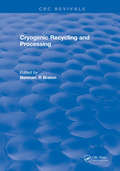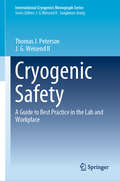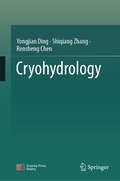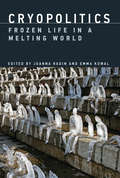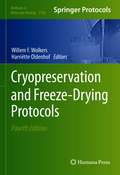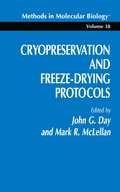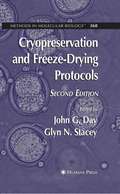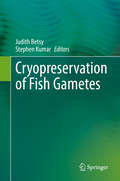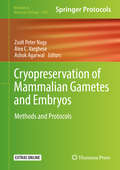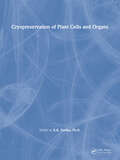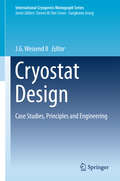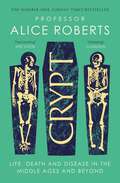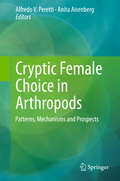- Table View
- List View
Cryogenic Heat Transfer (Chemical And Mechanical Engineering Ser.)
by Gregory Nellis Randall BarronCryogenic Heat Transfer, Second Edition continues to address specific heat transfer problems that occur in the cryogenic temperature range where there are distinct differences from conventional heat transfer problems. This updated version examines the use of computer-aided design in cryogenic engineering and emphasizes commonly used computer programs to address modern cryogenic heat transfer problems. It introduces additional topics in cryogenic heat transfer that include latent heat expressions; lumped-capacity transient heat transfer; thermal stresses; Laplace transform solutions; oscillating flow heat transfer, and computer-aided heat exchanger design. It also includes new examples and homework problems throughout the book, and provides ample references for further study. New in the Second Edition: Expands on thermal properties at cryogenic temperatures to include latent heats and superfluid helium Develops the material on conduction heat transfer and divides it into four separate chapters to facilitate understanding of the separate features and computational techniques in conduction heat transfer Introduces EES (Engineering Equation Solver), a computer-aided design tool, and other computer applications such as Maple Describes special features of heat transfer at cryogenic temperatures such as analysis with variable thermal properties, heat transfer in the near-critical region, Kapitza conductance, and network analysis for free-molecular heat transfer Includes design procedures for cryogenic heat exchangers Cryogenic Heat Transfer, Second Edition discusses the unique problems surrounding conduction heat transfer at cryogenic temperatures. This second edition incorporates various computational software methods, and provides expanded and updated topics, concepts, and applications throughout. The book is designed as a textbook for students interested in thermal problems occurring at cryogenic temperatures and also serves as reference on heat transfer material for practicing cryogenic engineers.
Cryogenic Helium Refrigeration for Middle and Large Powers (International Cryogenics Monograph Series)
by Guy Gistau BaguerThis book offers a practical introduction to helium refrigeration engineering, taking a logical and structured approach to the design, building, commissioning, operation and maintenance of refrigeration systems. It begins with a short refresher of cryogenic principles, and a review of the theory of heat exchangers, allowing the reader to understand the importance of the heat exchanger role in the various thermodynamic cycle structures. The cycles are considered from the simplest (Joule Thomson) to the most complicated ones for the very large refrigeration plants and, finally, those operating at temperatures lower than 4.5 K. The focus then turns to the operation, ability and limitations of the main components, including room temperature cycle screw compressors, heat exchangers, cryogenic expansion turbines, cryogenic centrifugal compressors and circulators. The book also describes the basic principles of process control and studies the operating situations of helium plants, with emphasis on high level efficiency. A major issue is helium purity, and the book explains why helium is polluted, how to purify it and then how to check its purity, to ensure that all components are filled with pure helium prior to starting. Although the intention of the book is not to design thermodynamic cycles, it is of interest to a designer or operator of a cryogenic system to perform some simplified calculations to get an idea of how components or systems are behaving. Throughout the book, such calculations are generally performed using Microsoft® Excel and the Gaspak® or Hepak® software.
Cryogenic Recycling and Processing
by Norman. R BratonThe purpose of this book is to promote useful knowledge in the field of cryogenics. To accomplish this, the manuscript presents a composite of the state-of-the-art knowledge, research, and application of cryogenic processes.
Cryogenic Safety: A Guide to Best Practice in the Lab and Workplace (International Cryogenics Monograph Series)
by Thomas J. Peterson J. G. Weisend IIThis book describes the current state of the art in cryogenic safety best practice, helping the reader to work with cryogenic systems and materials safely. It brings together information from previous texts, industrial and laboratory safety polices, and recent research papers. Case studies, example problems, and an extensive list of references are included to add to the utility of the text. It describes the unique safety hazards posed by cryogenics in all its guises, including issues associated with the extreme cold of cryogenics, the flammability of some cryogenic fluids, the displacement of oxygen by inert gases boiling off from cryogenic fluids, and the high pressures that can be formed during the volume expansion that occurs when a cryogenic fluid becomes a room temperature gas. A further chapter considers the challenges arising from the behavior of materials at cryogenic temperatures. Many materials are inappropriate for use in cryogenics and can fail, resulting in hazardous conditions. Despite these hazards, work at cryogenic temperatures can be performed safely. The book also discusses broader safety issues such as hazard analysis, establishment of a safe work culture and lessons learned from cryogenic safety in accelerator labs. This book is designed to be useful to everyone affected by cryogenic hazards regardless of their expertise in cryogenics.
Cryohydrology
by Yongjian Ding Shiqiang Zhang Rensheng ChenThis book is devoted to the study of cryohydrology in hydrological research in cold regions through theoretical aspects, field observations, remote sensing and GIS, hydrological model, and impacts on regional and global scales. Understanding cryohydrology is a prerequisite to the hydrological processes in cold regions. The book aims to serve as a guide for understanding and developing cryohydrology by observation and modeling. It is motivated by recent rapid advances in cryospheric science including the discipline trees, in addition to the impact of cryospheric changes on different scales. Chapters are carefully developed to cover (1)development of cryohydrology, (2) research methods, (3) ablation, runoff generation and routing, (4) meltwater runoff, (5) hydrochemistry, (6) river sediment, (7) roles in watershed, and (8) impact on global water cycle. It addresses the above issues with a holistic and systematic approach that utilizes observation to simulation. The book is written for scholars working in hydrological research fields as well as stakeholders engaging in environmental sustainability in cold regions.
Cryopolitics: Frozen Life in a Melting World (The\mit Press Ser.)
by Emma Kowal Joanna RadinThe social, political, and cultural consequences of attempts to cheat death by freezing life.As the planet warms and the polar ice caps melt, naturally occurring cold is a resource of growing scarcity. At the same time, energy-intensive cooling technologies are widely used as a means of preservation. Technologies of cryopreservation support global food chains, seed and blood banks, reproductive medicine, and even the preservation of cores of glacial ice used to study climate change. In many cases, these practices of freezing life are an attempt to cheat death. Cryopreservation has contributed to the transformation of markets, regimes of governance and ethics, and the very relationship between life and death. In Cryopolitics, experts from anthropology, history of science, environmental humanities, and indigenous studies make clear the political and cultural consequences of extending life and deferring death by technoscientific means.The contributors examine how and why low temperatures have been harnessed to defer individual death through freezing whole human bodies; to defer nonhuman species death by freezing tissue from endangered animals; to defer racial death by preserving biospecimens from indigenous people; and to defer large-scale human death through pandemic preparedness. The cryopolitical lens, emphasizing the roles of temperature and time, provokes new and important questions about living and dying in the twenty-first century.ContributorsWarwick Anderson, Michael Bravo, Jonny Bunning, Matthew Chrulew, Soraya de Chadarevian, Alexander Friedrich, Klaus Hoeyer, Frédéric Keck, Eben Kirksey, Emma Kowal, Joanna Radin, Deborah Bird Rose, Kim TallBear, Charis Thompson, David Turnbull, Thom van Dooren, Rebecca J. H. Woods
Cryopreservation and Freeze-Drying Protocols (Methods in Molecular Biology #2180)
by Willem F. Wolkers Harriëtte OldenhofThis fourth edition explores fully up-to-date standardly used cryopreservation, vitrification, and freeze-drying protocols for specimens that are used for research purposes, conservation of genetic reserves, and applications in agriculture and medicine. Beginning with a section on the fundamentals as well as the use of mathematical modeling to solve cryobiological problems, the book continues with sections on technological aspects of freezing and drying, analytical methods to study protectant loading of cells and tissues, cell behavior during freezing and drying, and thermodynamic properties of preservation solutions, as well as cryopreservation, vitrification, and freeze-drying protocols for a wide variety of samples and different applications. Written for the highly successful Methods in Molecular Biology series, chapters include introductions to their respective topics, lists of the necessary materials and reagents, step-by-step, readily reproducible laboratory protocols, and tips on troubleshooting and avoiding known pitfalls. Thorough and authoritative, Cryopreservation and Freeze-Drying Protocols, Fourth Edition serves as an ideal guide for researchers and technical assistants in academia and industry with a background in life sciences, medicine, or engineering who want to investigate freezing and drying of biological systems or set up methods to safely store biological specimens while maintaining their function upon reconstitution.
Cryopreservation and Freeze-Drying Protocols (Methods in Molecular Biology #38)
by Mark R. Mclellan John G. DayThis book provides detailed protocols for all the latest methodologies used to assure the long-term biostorage of a diverse range of biological materials. Developed in expert laboratories, the protocols have been painstakingly perfected over the years to provide time-tested, step-by-step instructions that ensure robust and reproducible results. Each protocol deals with the preservation of an organelle, cell, or tissue type, and is accessible even to the nonspecialist because of its cookbook approach. Novel protocols can be readily developed with the help of the "hands-on" Notes sections. Cryopreservation and Freeze-Drying Protocols is an indispensable reference work for both the individual researcher, and all those who want to establish or improve biostorage systems in their laboratories. Its applications range from microbial culture collections, botanic gardens, and zoos to animal husbandry, aquaculture, medicine, human fertilization, and cell and molecular biology.
Cryopreservation and Freeze-Drying Protocols, 2nd Edition (Methods in Molecular Biology #368)
by John G. Day Glyn StaceyThis widely expanded second edition offers a compilation of robust, reproducible techniques for the conservation of a wide range of biological materials. It includes novel approaches and protocols that were not preservable when the first edition was published.<P><P> The book begins with a discussion of long term ex situ conservation of biological resources, the role of biological resource centers, and fundamental principles of freeze-drying and cryopreservation. Each chapter focuses on the preservation of specific biological materials, including proteins, mircroorganisms, cell lines, and multicellular structures.
Cryopreservation of Fish Gametes
by Judith Betsy Stephen KumarUnderstanding the reproductive physiology and endocrinology of fishes is essential for captive maturation and seed production in the field of aquaculture. Studying the spermatology of fishes is a comparatively new focus in aquaculture, which has emerged as an important area of fish research over the past two decades. In this regard, the cryopreservation of fish gametes is a crucial aspect. Moreover, energetics studies of gametes have become essential, considering the loss of vigour in the spermatozoa after cryopreservation.The latest development in this context is the cryopreservation of spermatogonial stem cell, which is also covered in the book, along with detailed information on embryo cryopreservation in fishes and crustaceans. The role of cryopreservation in conservation programmes is another important aspect, one that will especially interest biologists.This book addresses central issues in fish gamete cryopreservation and breeding, while also reviewing the history of cryopreservation. Its most unique feature is the breadth of its coverage, from basic information on reproduction in fishes, to such advanced topics as embryo cryopreservation. Chiefly intended as a handy troubleshooting guide, the book represents a valuable resource for research students in related fields.
Cryopreservation of Mammalian Gametes and Embryos: Methods and Protocols (Methods in Molecular Biology #1568)
by Ashok Agarwal Alex C. Varghese Zsolt Peter NagyThis volume provides a comprehensive and technical presentation of numerous aspects of reproductive cell tissue cryopreservation, and presents readers with current procedures and detailed discussions of novel techniques and the latest innovations. The chapters in this book are divided into five parts and cover subjects such as: immature oocyte cryopreservation, human sperm vitrification and slow-freezing, directional freezing of ovarian tissue, automated vitrification systems, and detailed protocols on popular and commercially available cryopreservation/vitrification systems. Written in the highly successful Methods in Molecular Biology series format, chapters include introductions to their respective topics, lists of the necessary materials and reagents, step-by-step, readily reproducible laboratory protocols, and tips on troubleshooting and avoiding known pitfalls. Cutting-edge and practical, Cryopreservation of Mammalian Gametes and Embryos: Methods and Protocols includes chapters written by leading experts in the field and is a valuable resource for anyone interested in the field of cryopreservation.
Cryopreservation of Plant Cells and Organs
by K.K. KarthaThis monograph will put the topic of Cryopreservation of Plant Cells and Organs in perspective. Originally published in 1985.
Cryostat Design: Case Studies, Principles and Engineering (International Cryogenics Monograph Series)
by J. G. Weisend IIThis book enables the reader to learn the fundamental and applied aspects of practical cryostat design by examining previous design choices and resulting cryostat performance. Through a series of extended case studies the book presents an overview of existing cryostat design covering a wide range of cryostat types and applications, including the magnet cryostats that comprise the majority of the Large Hadron Collider at CERN, space-borne cryostats containing sensors operating below 1 K, and large cryogenic liquid storage vessels. It starts with an introductory section on the principles of cryostat design including practical data and equations. This section is followed by a series of case studies on existing cryostats, describing the specific requirements of the cryostat, the challenges involved and the design choices made along with the resulting performance of the cryostat. The cryostat examples used in the studies are chosen to cover a broad range of cryostat applications and the authors of each case are leading experts in the field, most of whom participated in the design of the cryostats being described. The concluding chapter offers an overview of lessons learned and summarises some key hints and tips for practical cryostat design. The book will help the reader to expand their knowledge of many disciplines required for good cryostat design, including the cryogenic properties of materials, heat transfer and thermal insulation, instrumentation, safety, structures and seals.
Crypt: Life, Death and Disease in the Middle Ages and Beyond
by Alice RobertsTHE SUNDAY TIMES NO. 1 BESTSELLERCHOSEN BY WATERSTONES AS ONE OF THEIR BEST HISTORY BOOKS OF 2024 'Compulsive . . . A wonderful display of how modern archaeology can bring hidden histories to life' Daily Telegraph 'Gripping . . . I found it hard to put down' Evening Standard 'Another really good book from archaeologist Alice Roberts . . . Helps you understand the facts on a technical level, but also makes you feel them in your bones' New Scientist 'Robert's reflections on Thomas Becket and Canterbury Cathedral are especially entertaining . . . Fascinating' Spectator The new book by Sunday Times bestselling author of Ancestors and Buried - the final instalment in Professor Alice Roberts' acclaimed trilogy.We can unlock secrets from bones preserved for centuries in tombs, graves and crypts. The history of the Middle Ages is typically the story of the rich and powerful, there&’s barely a written note for most people&’s lives. Archaeology represents another way of interrogating our history. By using cutting-edge science to examine human remains and burials, it is possible to unearth details about how individuals lived and died that give us a new understanding of the past – one that is more intimate and inclusive than ever before. The seven stories in Crypt are not comforting tales. We meet the patients at one of the earliest hospitals in England and the victims of the St Brice&’s Day Massacre. We see a society struggling to make sense of disease, disability and death, as incurable epidemics sweep through medieval Europe. We learn of a protracted battle between Church and State that led to the murder of Thomas Becket and the destruction of the most famous tomb in England. And we come face to face with the archers who went down with Henry VIII&’s favourite ship, the Mary Rose. Beautifully written and expertly researched by Professor Alice Roberts, Crypt is packed with thrilling discoveries that will make you see the history of Britain afresh.
Cryptic Female Choice in Arthropods: Patterns, Mechanisms and Prospects
by Alfredo V. Peretti Anita AisenbergThis timely book revisits cryptic female choice in arthropods, gathering detailed contributions from around the world to address key behavioral, ecological and evolutionary questions. The reader will find a critical summary of major breakthroughs in taxon-oriented chapters that offer many new perspectives and cases to explore and in many cases unpublished data. Many groups of arthropods such as spiders, harvestmen, flies, moths, crickets, earwigs, beetles, eusocial insects, shrimp and crabs are discussed. Sexual selection is currently the focus of numerous and controversial theoretical and experimental studies. Selection in mating and post-mating patterns can be shaped by several different mechanisms, including sperm competition, extreme sexual conflict and cryptic female choice. Discrimination among males during or after copulation is called cryptic female choice because it occurs after intromission, the event that was formerly used as the definitive criterion of male reproductive success and is therefore usually difficult to detect and confirm. Because it sequentially follows intra- and intersexual interactions that occur before copulation, cryptic female choice has the power to alter or negate precopulatory sexual selection. However, though female roles in biasing male paternity after copulation have been proposed for a number of species distributed in many animal groups, cryptic female choice continues to be often underestimated. Furthermore, in recent years the concept of sexual conflict has been frequently misused, linking sexual selection by female choice irrevocably and exclusively with sexually antagonistic co-evolution, without exploring other alternatives. The book offers an essential source of information on how two fields, selective cooperation and individual sex interests, work together in the context of cryptic female choice in nature, using arthropods as model organisms. It is bound to spark valuable discussions among scientists working in evolutionary biology across the world, motivating new generations to unveil the astonishing secrets of sexual biology throughout the animal kingdom.
Cryptic Species: Morphological Stasis, Circumscription, and Hidden Diversity (Systematics Association Special Volume Series)
by Simon J. Mayo Alexandre K. MonroCryptic species are organisms which look identical, but which represent distinct evolutionary lineages. They are an emerging trend in organismal biology across all groups, from flatworms, insects, amphibians, primates, to vascular plants. This book critically evaluates the phenomenon of cryptic species and demonstrates how they can play a valuable role in improving our understanding of evolution, in particular of morphological stasis. It also explores how the recognition of cryptic species is intrinsically linked to the so-called 'species problem', the lack of a unifying species concept in biology, and suggests alternative approaches. Bringing together a range of perspectives from practicing taxonomists, the book presents case studies of cryptic species across a range of animal and plant groups. It will be an invaluable text for all biologists interested in species and their delimitation, definition, and purpose, including undergraduate and graduate students and researchers.
Cryptococcus neoformans: Methods and Protocols (Methods in Molecular Biology #2775)
by Erin E. McClellandThis volume explores the latest developments in the study of Cryptococcus neoformans and its pathology, along with discussion on newly used therapeutics. The chapters in this book cover a wide range of protocols commonly used in Cryptococcus research such as animal models, genetics techniques, virulence factor phenotyping, and microscopy. Written in the highly successful Methods in Molecular Biology series format, chapters include introductions to their respective topics, lists of the necessary materials and reagents, step-by-step, readily reproducible laboratory protocols, and tips on troubleshooting and avoiding known pitfalls.Cutting-edge and thorough, Cryptococcus neoformans: Methods and Protocols is a valuable resource that will help researchers further enhance their understanding of this pathogenic yeast, and will aid in new discoveries and therapeutics.
Cryptosporidiosis of Man and Animals
by J. P. DubeyThis book attempts to provide a broad coverage of current information needed by public health workers, physicians, veterinarians, parasitologists, technicians, and various biologists who encounter or work with the parasitic disease Cryptosporidium.
Cryptosporidium and Cryptosporidiosis
by Lihua Xiao Ronald FayerFrom the microscopic observation of infection to the widespread application of molecular techniques in taxonomy and epidemiology, to the genome sequencing of two major species and advances in biochemistry, phylogeny, and water treatment, new information on this fascinating genus continues to mount as we discover and utilize the latest scientific te
Cryptosporidium: Methods and Protocols (Methods in Molecular Biology #2052)
by Jan R. Mead Michael J. ArrowoodThis book encompasses broad aspects of Cryptosporidium research with established methods that have been improved and expanded over the years as well as recent cutting-edge techniques. Within this collection are numerous molecular methods as well as protocols for genotyping and diagnostics, while also including room for in vitro cell culture techniques to address the issues with growing this difficult organism continuously. Written for the highly successful Methods in Molecular Biology series, chapters include introductions to their respective topics, lists of the necessary materials and reagents, step-by-step, readily reproducible laboratory protocols, and tips on troubleshooting and avoiding known pitfalls. Authoritative and practical, Cryptosporidium: Methods and Protocols serves as an idea guide to the inherent challenges of working with cryptosporidial parasites to provide a foundation for new investigators to build upon.
Cryptosporidium: Methods and Protocols (Methods in Molecular Biology #2978)
by Jan R. Mead Michael J. ArrowoodThis second edition volume expands on the previous edition with new chapters discussing the latest protocols that encompass the detection, characterization, and genomic analysis of Cryptosporidium. The first few chapters in this book focus on diagnostic assays, such as traditional microscopy-based techniques, nucleic acid-based molecular detection, and immunoassay-based methodologies. Several chapters cover whole genome sequencing methodologies, genotyping approaches, and novel techniques such as hybridization bait capture analyses. A significant portion of this book is dedicated to functional genomics and experimental models, with discussions on tools used for genetic manipulation (including CRISPR/cas9), gene silencing, and host-pathogen interactions. The volume concludes with chapters exploring drug discovery and testing, highlighting high-content screening methods, phenotypic assays, and efficacy testing of potential disinfectants and therapeutics. Written in the highly successful Methods in Molecular Biology series format, chapters include introductions to their respective topics, lists of the necessary materials and reagents, step-by-step, readily reproducible laboratory protocols, and tips on troubleshooting and avoiding known pitfalls.Cutting-edge and comprehensive, Cryptosporidium: Methods and Protocols, Second Edition is a valuable tool for researchers interested in gaining more insight on foundational and innovative Cryptosporidium research, which will inspire future advancements in this field.
Cryptosporidium: Parasite And Disease
by Simone M. Cacciò Giovanni WidmerThis new volume on Cryptosporidium and Cryptosporidiosis discusses all relevant aspects of the biology, molecular biology, host-parasite interaction, epidemiology as well as diagnosis and treatment of these widespread parasites. It represents a useful guide for physicians, microbiologists, veterinarians and water professionals seeking advanced knowledge and guidance about these important parasitic pathogens. A section on practical lab procedures discusses step-by-step guidelines for sample preparation and lab procedures. The new book may further serve as a reference work for graduate students in medical and veterinary microbiology.
Crystal Fire: The Invention of the Transistor and the Birth of the Information Age (Sloan Technology Series)
by Michael Riordan Lillian Hoddeson"With impeccable scholarship and meticulous research, this book covers an impressive sweep of history from the discovery of the electron to the first integrated circuit. ... A definitive account of the birth of the semiconductor industry." -London Daily Telegraph "In rich detail, Riordan and Hoddeson unfurl the development of the transistor and the lives of its three principal discoverers- John Bardeen, Walter Brattain, and William Shockley. . . . Standing on the shoulders of giants while harvesting the fruits of their own astonishing research, the triumvirate of the transistor created the device that has revolutionized life today, making possible television, computers, and other electronic devices." -Library Journal
Crystal Growth and Evaluation of Silicon for VLSI and ULSI
by Golla ErannaSilicon, as a single-crystal semiconductor, has sparked a revolution in the field of electronics and touched nearly every field of science and technology. Though available abundantly as silica and in various other forms in nature, silicon is difficult to separate from its chemical compounds because of its reactivity. As a solid, silicon is chemical
Crystal Healing for Women: A Modern Guide to the Power of Crystals for Renewed Energy, Strength, and Wellness
by Mariah K. LyonsCrystal Healing for WomenA Modern Guide to the Power of Crystals for Renewed Energy, Strength, and WellnessDiscover the physical, mental, and spiritual healing power of crystals and awaken the healer within. Believed to hold restorative powers over our health, crystals have served humanity for millennia. With Crystal Healing for Women, you can unlock the ancient secrets of healing and wisdom held within these stones. Crystal healer and Reiki Master Mariah K. Lyons shares her knowledge in this beautifully-illustrated, practical guide that helps women awaken to their feminine divinity and healing powers, and rekindle their instinctual relationship with nature. She also shows you how to select and care for crystals and incorporate them in rituals. You'll learn to intentionally utilize crystals, helping you to find deeper levels of spiritual growth, integrated healing, and sustainable well-being. Crystal Healing for Women features: • Crystal healing fundamentals: How crystal vibrational energy works as well as how to activate, charge, and cleanse your crystals. • 40 energetic self-care rituals: Daily and seasonal wellness practices plus focused healing and manifestation for fertility, pregnancy, the feminine cycle, anxiety, creativity, and love. • 50 healing crystal profiles: Modern interpretations, individual features, and beautiful photographs of stones with energetic properties and healing compatibilities. • 10 key crystals for women: An in-depth look at select stones chosen for their potency, healing power, and connection to Divine Feminine energy. • Crystals in everyday life: Where to place them in your home and on your body and how to work with them and create crystal-healing grids.
